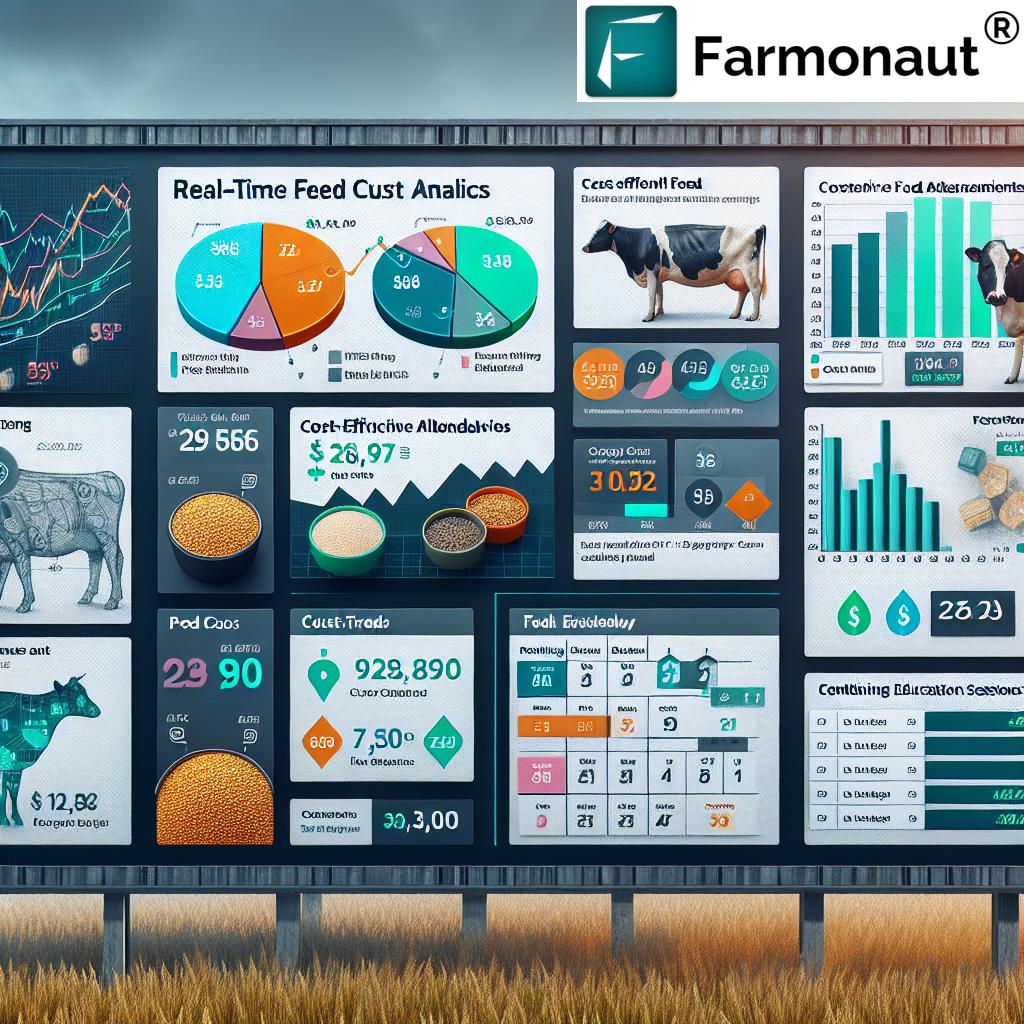Maximize Dairy Profits: 10 Expert Strategies to Slash Feed Costs in 2024 – Farmonaut’s Essential Guide
“Feed costs account for over 50% of total milk production expenses in dairy farming.”

Welcome to Farmonaut’s comprehensive guide on maximizing dairy profits through expert feed cost management strategies. As we enter 2024, the dairy industry continues to face significant challenges, with feed costs remaining a critical factor in overall profitability. Our upcoming webinar series aims to address these pressing issues and provide dairy farmers with actionable insights to optimize their operations.
The Growing Challenge of Feed Costs in Dairy Farming
In recent years, the dairy industry has witnessed a substantial increase in production expenses, with feed costs surpassing 50% of total milk production costs. This trend has put immense pressure on dairy farmers to find innovative solutions for reducing dairy production expenses without compromising on milk quality or animal welfare.
At Farmonaut, we understand the complexities of modern dairy farming and the need for cutting-edge agricultural solutions. Our agritech platform offers a range of tools designed to help farmers make data-driven decisions, optimize resource allocation, and ultimately boost profitability.
Introducing Our Expert Webinar Series
We are excited to announce our upcoming webinar, “Maximize Dairy Profits: 10 Expert Strategies to Slash Feed Costs in 2024.” This educational event is part of our commitment to providing valuable agricultural webinars for farmers and continuing education for dairy professionals. The webinar will explore ten key opportunities for feed cost savings, offering practical and profitable dairy farming strategies that can be implemented immediately.
What You’ll Learn in Our Webinar
- Effective dairy farm feed cost management techniques
- Strategies for managing rising fertilizer costs
- Mitigating the impact of corn and soybean meal price fluctuations
- Optimizing dairy nutrition for cost-effective production
- Leveraging agritech solutions for improved farm efficiency
Our expert speakers will dive deep into each of these topics, providing you with the knowledge and tools necessary to implement these strategies on your own farm.
10 Expert Strategies to Slash Feed Costs
Let’s take a closer look at the ten strategies we’ll be discussing in our webinar:
| Strategy | Estimated Cost Savings (%) |
|---|---|
| 1. Optimize forage quality | 10-15% |
| 2. Implement precision feeding | 5-8% |
| 3. Use feed additives strategically | 3-6% |
| 4. Adopt grazing management techniques | 8-12% |
| 5. Utilize by-product feeds | 4-7% |
| 6. Improve feed storage and handling | 3-5% |
| 7. Analyze feed composition regularly | 2-4% |
| 8. Implement ration balancing software | 4-6% |
| 9. Explore alternative protein sources | 5-8% |
| 10. Optimize herd genetics for feed efficiency | 6-10% |
As you can see, implementing these strategies has the potential to significantly reduce your feed costs and improve your dairy farm’s profitability.
Strategy 1: Optimize Forage Quality
Optimizing forage quality is crucial for reducing feed costs and improving dairy cow performance. High-quality forage can decrease the need for expensive concentrated feeds while maintaining or even increasing milk production. Here are some key points to consider:
- Harvest at the optimal stage of maturity
- Implement proper storage techniques to minimize nutrient loss
- Regularly test forage quality to adjust rations accordingly
- Consider using forage inoculants to improve fermentation and preservation
By focusing on forage quality, you can potentially save 10-15% on feed costs while ensuring your cows receive the nutrition they need.
Strategy 2: Implement Precision Feeding
Precision feeding involves tailoring the diet to meet the specific nutritional needs of individual cows or groups of cows based on their production level, stage of lactation, and other factors. This approach can lead to significant feed cost savings of 5-8%. Here’s how to implement precision feeding:
- Use advanced feed management software to formulate accurate rations
- Group cows based on their nutritional requirements
- Regularly monitor and adjust rations based on milk production and body condition scores
- Implement technologies like automated feed pushers to ensure consistent feed availability
Farmonaut’s satellite-based crop monitoring can help dairy farmers optimize their forage production, contributing to more efficient precision feeding strategies. Check out our web app to learn more about how we can assist you in this area.
Strategy 3: Use Feed Additives Strategically
Strategic use of feed additives can improve feed efficiency and potentially reduce overall feed costs by 3-6%. Some effective additives include:
- Rumen modifiers to enhance digestion
- Yeast cultures to improve rumen function
- Enzymes to break down complex carbohydrates
- Buffers to maintain optimal rumen pH
It’s essential to work closely with a nutritionist to determine which additives will be most beneficial and cost-effective for your herd.
Strategy 4: Adopt Grazing Management Techniques
Effective grazing management can lead to feed cost savings of 8-12% by maximizing the use of pasture and reducing reliance on purchased feeds. Consider implementing these techniques:
- Rotational grazing to optimize pasture utilization
- Pasture renovation to improve forage quality and yield
- Strategic supplementation to balance pasture nutrition
- Use of portable fencing for flexible grazing management
Farmonaut’s satellite imagery and AI-powered insights can help you monitor pasture health and make informed decisions about grazing management. Explore our Android app or iOS app to get started.

Strategy 5: Utilize By-Product Feeds
Incorporating by-product feeds into your dairy rations can result in feed cost savings of 4-7%. These feeds are often more economical than traditional ingredients and can provide valuable nutrients. Some popular by-product feeds include:
- Distillers grains
- Soybean hulls
- Cottonseed
- Beet pulp
When using by-product feeds, it’s crucial to consider their nutritional profiles, potential variability, and storage requirements.
“Farmonaut’s webinar offers 10 expert strategies to reduce dairy feed costs, potentially saving thousands annually.”
Strategy 6: Improve Feed Storage and Handling
Proper feed storage and handling can reduce waste and preserve nutrient quality, leading to potential savings of 3-5%. Consider these best practices:
- Invest in proper storage facilities to protect feed from moisture and pests
- Implement first-in, first-out inventory management
- Use appropriate equipment for feed mixing and delivery to ensure consistency
- Regularly maintain and clean feed storage and handling equipment
Strategy 7: Analyze Feed Composition Regularly
Regular feed analysis is crucial for optimizing rations and can lead to cost savings of 2-4%. By knowing the exact nutrient content of your feeds, you can avoid over- or under-feeding nutrients. Here’s what you should do:
- Conduct routine nutrient analysis of forages and other feed ingredients
- Adjust rations based on analysis results
- Monitor dry matter content, especially in silages and high-moisture feeds
- Use near-infrared spectroscopy (NIRS) for rapid, on-farm analysis when possible
Strategy 8: Implement Ration Balancing Software
Using advanced ration balancing software can help optimize feed formulations, potentially saving 4-6% on feed costs. These tools allow you to:
- Quickly formulate least-cost rations that meet nutritional requirements
- Evaluate multiple ingredient options and their economic impact
- Adjust rations based on current feed prices and availability
- Track feed inventory and project future needs
Farmonaut’s AI-powered advisory system can complement your ration balancing efforts by providing insights into crop yields and quality. Learn more about our services at our API page.
Strategy 9: Explore Alternative Protein Sources
With the volatility in soybean meal prices, exploring alternative protein sources can lead to feed cost savings of 5-8%. Some options to consider include:
- Canola meal
- Sunflower meal
- Peas and other legumes
- Insect-based proteins (emerging option)
When incorporating alternative protein sources, work closely with your nutritionist to ensure proper amino acid balancing and overall ration formulation.
Strategy 10: Optimize Herd Genetics for Feed Efficiency
Focusing on feed efficiency in your breeding program can lead to long-term feed cost savings of 6-10%. Consider these approaches:
- Select bulls with high feed efficiency ratings
- Use genomic testing to identify efficient animals in your herd
- Cull low-performing animals that are inefficient converters of feed to milk
- Balance feed efficiency with other important traits like milk production and health
Remember that genetic improvements take time, but the cumulative effects can be substantial in reducing feed costs over the years.
Leveraging Farmonaut’s Agritech Solutions
At Farmonaut, we’re committed to helping dairy farmers optimize their operations through innovative technology. Our satellite-based farm management solutions can provide valuable insights to support your feed cost reduction strategies:
- Real-time crop health monitoring to optimize forage production
- AI-based advisory for improved decision-making in crop management
- Weather forecasting to plan harvesting and grazing activities
- Resource management tools to track feed inventory and usage
Explore our range of solutions by visiting our web app or downloading our mobile apps for Android and iOS.
Join Our Webinar Series
Don’t miss this opportunity to gain in-depth knowledge on reducing dairy production expenses and implementing profitable dairy farming strategies. Our webinar series offers:
- Live Q&A sessions with industry experts
- Interactive polls and discussions
- Downloadable resources and checklists
- Networking opportunities with fellow dairy professionals
- Continuing education credits for dairy professionals
Register now to secure your spot and take the first step towards maximizing your dairy farm’s profitability in 2024 and beyond.
Frequently Asked Questions
Q: How can Farmonaut’s technology help me reduce feed costs?
A: Farmonaut’s satellite-based crop monitoring and AI-powered insights can help you optimize forage production, manage pastures more effectively, and make data-driven decisions about crop management, all of which contribute to reducing overall feed costs.
Q: Are these strategies suitable for small-scale dairy farms?
A: Yes, many of these strategies can be adapted for small-scale dairy farms. Our webinar will provide guidance on how to implement these techniques regardless of farm size.
Q: How often should I analyze my feed composition?
A: We recommend analyzing your feed composition at least monthly, or more frequently if you notice changes in milk production or feed quality.
Q: Can implementing these strategies impact milk quality?
A: When implemented correctly, these strategies should not negatively impact milk quality. In fact, optimizing nutrition can often lead to improvements in milk composition and quality.
Q: How long does it take to see results from genetic improvements for feed efficiency?
A: Genetic improvements typically take several years to show significant results across the herd. However, you may start seeing improvements in individual animals within 1-2 lactation cycles.
Conclusion
Reducing feed costs is crucial for maintaining a profitable dairy operation in today’s challenging economic environment. By implementing the strategies discussed in our webinar and leveraging Farmonaut’s agritech solutions, you can significantly improve your farm’s efficiency and profitability.
We invite you to join our upcoming webinar series to dive deeper into these expert strategies and learn how to apply them to your unique farming situation. Together, we can navigate the challenges of rising production costs and build a more sustainable future for the dairy industry.
Don’t forget to explore Farmonaut’s range of services to support your dairy farm management:
For developers interested in integrating our technology into their own solutions, check out our API and API Developer Docs.
Stay tuned for more updates and educational resources from Farmonaut as we continue to support the agricultural community with cutting-edge technology and expert insights.






